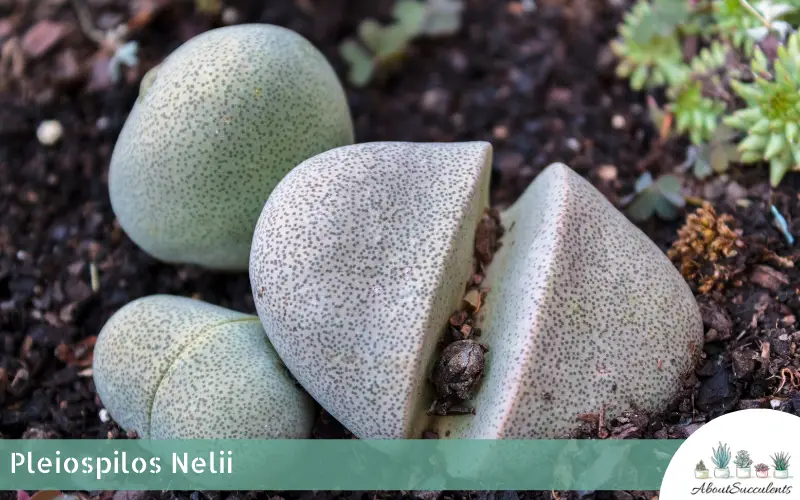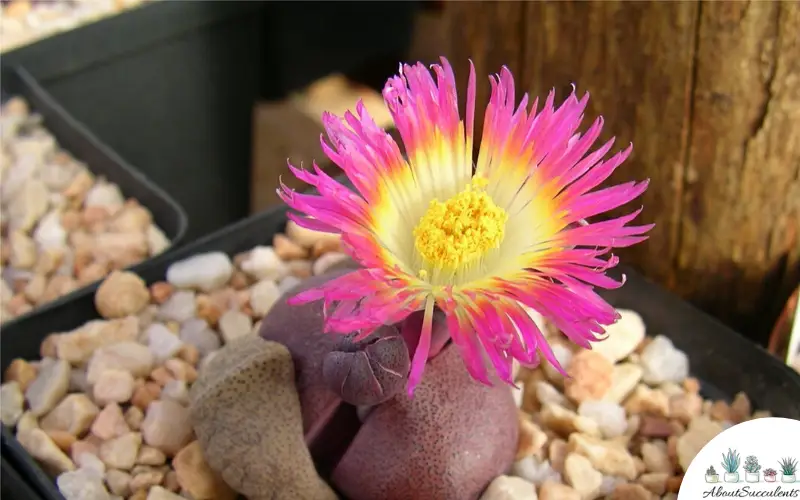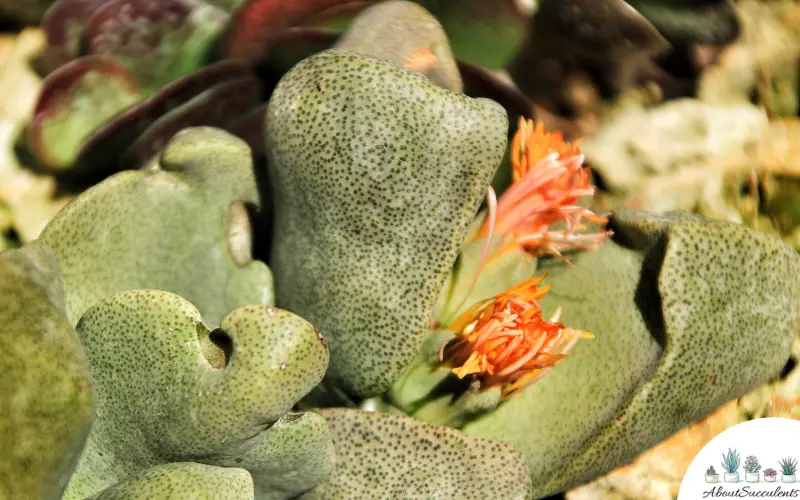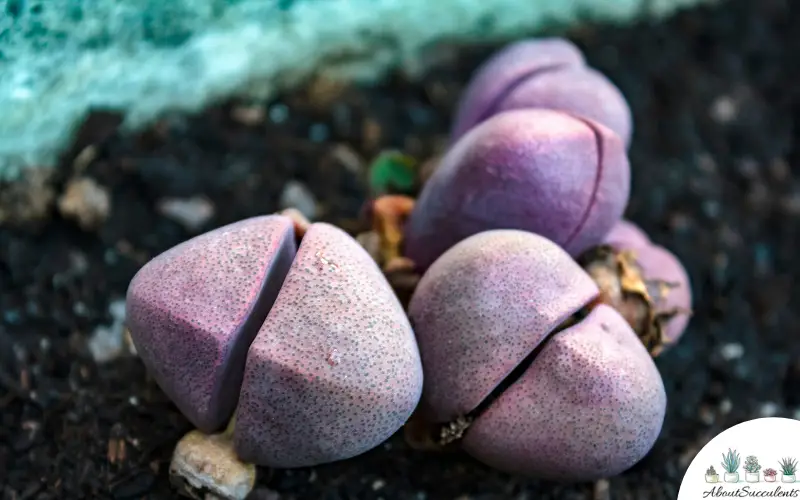
Pleiospilos nelii is an unusual-looking succulent but in a delightful, intriguing way. Its body has 2 to 4 spherical-shaped leaves that are merged at its base and grows to a height of 1.96 to 3.15-inches (5cm to 8cm).
The globular appearance of the leaves makes Pleiospilos nelli look like a rock with greenish speckles on the surface. The leaves vary in color from grey-green to brownish.
Pleiospilos nelii has a noticeable cleft or split in the middle which is why the succulent is also called “Split Rock”, “Stone Plant”, and “Liver Plant”. Pleiospilos nelii originates from the Aizoaceae family and is native to South Africa.
General Information:
Also known as: Split Rock, Stone Plant, and Liver Plant
Plant Family: Aizoaceae
Origin: South Africa
Height: 1.96 to 3.15-inches (5cm to 8cm))
Exposure: Direct exposure to sunlight up to 5 hours
Water Needs: Controlled and tightly-restricted watering schedule during the summer months; very little to no watering in the winter or cold season.
Soil Type: Sandy soil or a potting soil mix composed of 2 parts peat moss, 1 part clean sand, and 1 part perlite.
Soil pH: Acidic (6.1 to 6.5 pH)
How to Grow and Care for Pleiospilis Nelii

Pleiospilos nelii is a wonderful indoor plant that can be a perfect addition to your windowsill. Split Rock is also very adaptable to changes in weather. Under normal temperature circumstances in Europe and North America, a mature succulent can survive an entire year without water.
Pleiospilos nelii grows with 2 pairs of leaves. The lower leaves are from the previous year while the top ones are from the current year. The new leaves grow from the middle of the succulent or its split, and consume the old leaves.
1. Sunlight
Pleiospilos nelii loves full exposure to sun. It will grow very well with partial exposure to sunlight. The specks on its leaves function like windows that allow sunlight to enter its body and initiate photosynthesis.
If grown indoors, place Split Rock under a growth light and have the pot positioned near the South window where it can get indirect sunlight.
2. Watering
Pleiospilos nelii does not require much water during the growing season. From late summer to early summer, you can water Split Rock once-a-week. During the winter season, when temperatures fall below 9°C or 48.2°F, its watering schedule should be further restricted.
As a rule, Pleiospilos nelii should only receive water when its soil is dry to the touch. Overwatering the plant will extend the life of the old leaves and will cause its roots to rot. The infection can spread and potentially contaminate the entire succulent.
When the leaves are splitting, do not water Split Rock. Unlike other types of succulents, Pleiospilos nelii’s leaves remain plump and full.

3. Pot and Soil
The pot for Pleiospilos nelii should at least be 3.9-inches or 10cm deep because the succulent has a very long taproot.
Split Rock will grow best in compost that drains very well. Do not use organic ingredients as the plant does respond favorably with it. You can also use garden soil as long as it has been sterilized in a 93°C or 200°F oven for 20 minutes.
It is also recommended to add 2 parts peat moss, 1 part sand, and 1 part perlite to the potting mixture. These ingredients will help improve air circulation and the drainage capacity of the soil.
How to Propagate Pleiospilos Nelii
Pleiospilos nelii can easily be propagated by seeds or division. It is recommended to propagate Split Rock with division because the process of growing the succulent from seed is a long process.

1. Seed Method
Step 1: Seeds of Split Rock can be harvested from its flower pod or bought online. Summer is the best time for sowing seeds.
Step 2: Soak the seeds in water for a period of 24 hours.
Step 3: After 24 hours, plant the seeds in a layer of sandy soil. Allow the seeds to naturally germinate by keeping the soil moist.
2. Division Method
Step 1: Remove the clumps in the spring or before the plant starts growing new leaves.
Step 2: Use a sharp and sterilized knife to remove the leaf.
Step 3: Place the leaf under a shaded area for a few days or until it develops hard calluses.
Step 4: Once the leaf has developed calluses, plant it in sandy soil.
Frequently Asked Questions
Is Pleiospilos Nelii Toxic for Cats and Dogs?
Pleiospilos Nelii does not appear in the list of toxic plants for cats and dogs that is presented on the website of the American Society for the Prevention of Cruelty to Animals (ASPCA).
Why is my Pleiospilos Nelii Succulent Dying?
The most common reason why your Pleiospilos nelii succulent is dying is overwatering.
Split Rock is a desert plant that can survive long periods of drought. The reason for its resiliency to dry periods is because Pleiospilos nelii stores water in its bladder cells which means moisture from the soil is readily absorbed by the plant.
If the old leaves are still present after 1 year, you are giving the succulent too much water and keeps the new pair of leaves from growing out of its center.
Does Pleiospilos Nelii Produce Flowers?
Pleiospilos nelii produces large flowers that look like daisies. The flowers emit a fragrance that is comparable to the smell of coconut. At 2.95-inches or 7.5cm across, the flowers are large in proportion to the size of the plant.
Split Rock’s alluring appearance is due to its beautiful flowers that have a yellow to copper-orange color.
The succulent’s flowers usually bloom in early spring. The flowers open up in the mid-afternoon and close up before the sunset.
Last Updated on June 12, 2022 by Sofia Lara